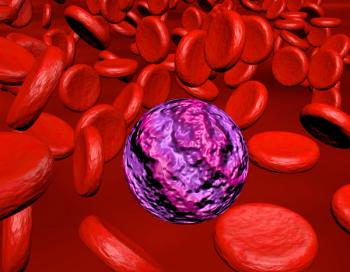
TKIs in CML Linked With Vascular Events
Treatment with the BCR-ABL tyrosine kinase inhibitors dasatinib, nilotinib, and ponatinib was associated with increased risk for vascular occlusive events in patients with CML compared with imatinib.
Treatment with the BCR-ABL tyrosine kinase inhibitors (TKIs) dasatinib, nilotinib, and ponatinib was associated with increased risk for vascular occlusive events in patients with chronic myeloid leukemia (CML) compared with imatinib, according to the results of a meta-analysis
“Treatment with dasatinib, nilotinib, and ponatinib should be associated with frequent cardiovascular monitoring and an intensive support of comorbidities,” wrote researcher Jonathan Douxfils, PharmD, PhD, of the department of pharmacy, Namur Thrombosis and Hemostasis Center, Namur Research Institute for Life Sciences, University of Namur, Namur, Belgium, and colleagues.
According to the study, patients with CML taking ponatinib and nilotinib experienced higher levels of peripheral artery occlusive disease both in clinical trials and in post-marketing experience. The US Food and Drug Administration included a boxed warning on the label of ponatinib that indicated that 8% of patients assigned the drug experienced serious arterial thrombosis.
With this meta-analysis, Douxfils and colleagues wanted to compare risk for vascular occlusive events among newer BCR-ABL TKIs compared with the older TKI imatinib. The review included published papers and abstracts studying bosutinib, dasatinib, nilotinib, and ponatinib. Ten studies including 3,043 patients were identified and included in this analysis. Nine of the studies included information on vascular occlusive events.
The analysis showed that vascular occlusive events occurred in 5.88% of patients treated with newer TKIs compared with 1.04% of patients treated with imatinib. Patients assigned to a new generation TKI had a significantly increased risk for vascular occlusive events (fixed effect model odds ratio [FEM OR], 3.45 [95% CI, 2.30–5.18]). This increased risk was found for ponatinib (OR, 3.47), nilotinib (OR, 3.42), and dasatinib (OR, 3.86) compared with imatinib. No statistically significant increased risk was seen with bosutinib.
The researchers also compared overall survivor and efficacy with the newer generation TKIs compared with imatinib. The data showed similar mortality rates at 1 year among patient assigned new generation TKIs and imatinib. However, 44.8% of patients assigned to a newer TKI had a major molecular response (MMR) compared with 27.35% of patients assigned imatinib.
Increased risk for dasatinib was driven mainly by results of the DASISION trial and increased risk for nilotinib was driven mainly by results of the ENEST trial. Removal of the data from these trials significantly affected the results, the researchers noted.
“Compared with other second- and third-generation TKIs, bosutinib does not show an increase in the risk of cardiovascular events,” the researchers wrote. “However, only the BELA trial is included in this analysis, and the lack of power in that study possibly masks the harmful effect of bosutinib on cardiovascular outcomes (only 248 and 251 patients in the bosutinib and the imatinib arms, respectively, were included).”
One potential limitation to the study was that the researchers were unable to access information on baseline cardiac risk factors in each of the studies included.
“Moreover, the way of reporting adverse cardiovascular events in trials of cancer therapies is controversial and can compromise detection of cardiotoxic effects and limit the ability to compare safety data between trials,” the researchers wrote.
“Further dose-ranging studies are required to define the dose regimen of each BCR-ABL TKI that will provide the best benefit-risk profile. Finally, monitoring the response at the individual level is of utmost importance to reduce the risk of vascular occlusive events while maintaining the MMR benefit,” the researchers wrote.
Newsletter
Stay up to date on recent advances in the multidisciplinary approach to cancer.


















































































